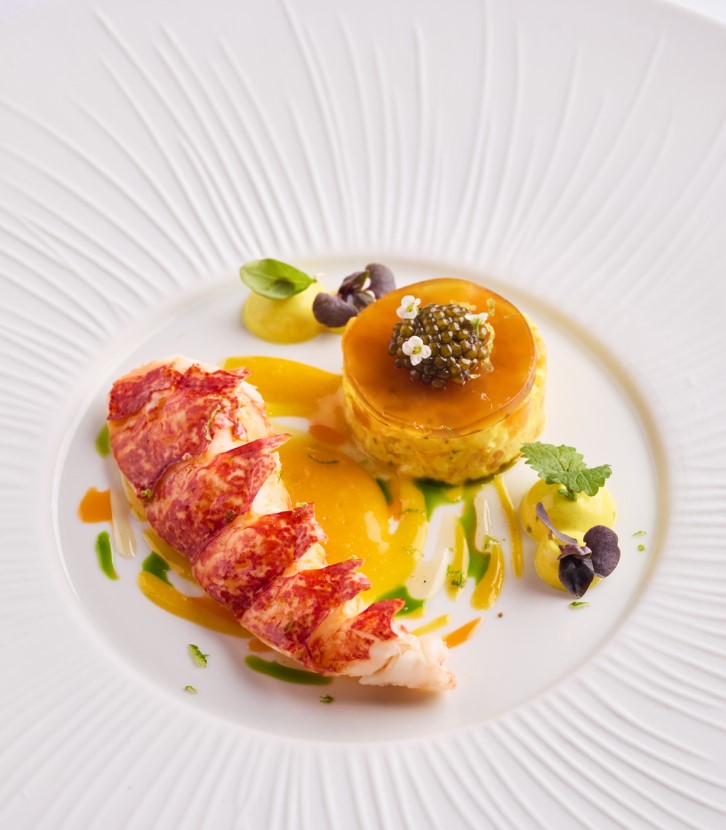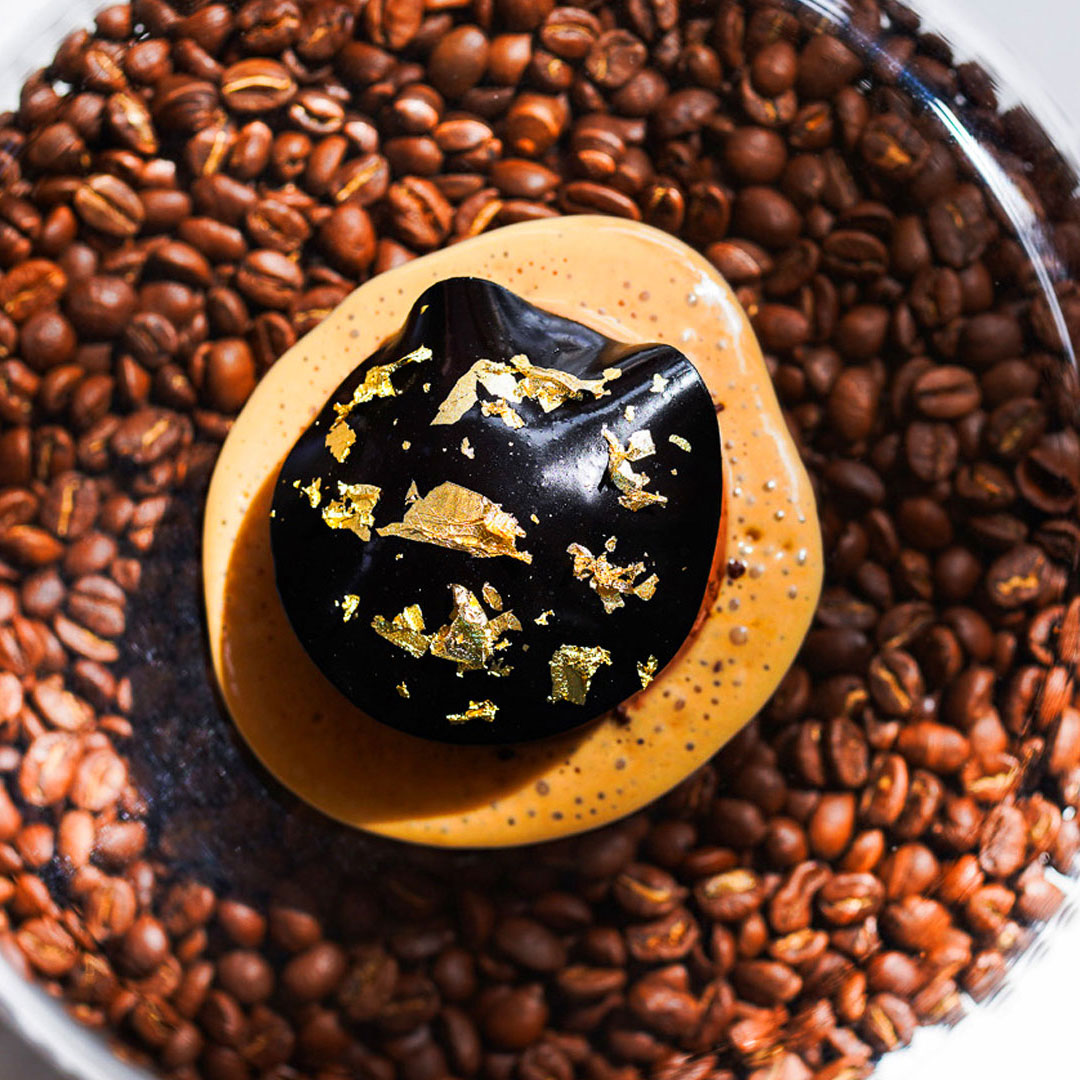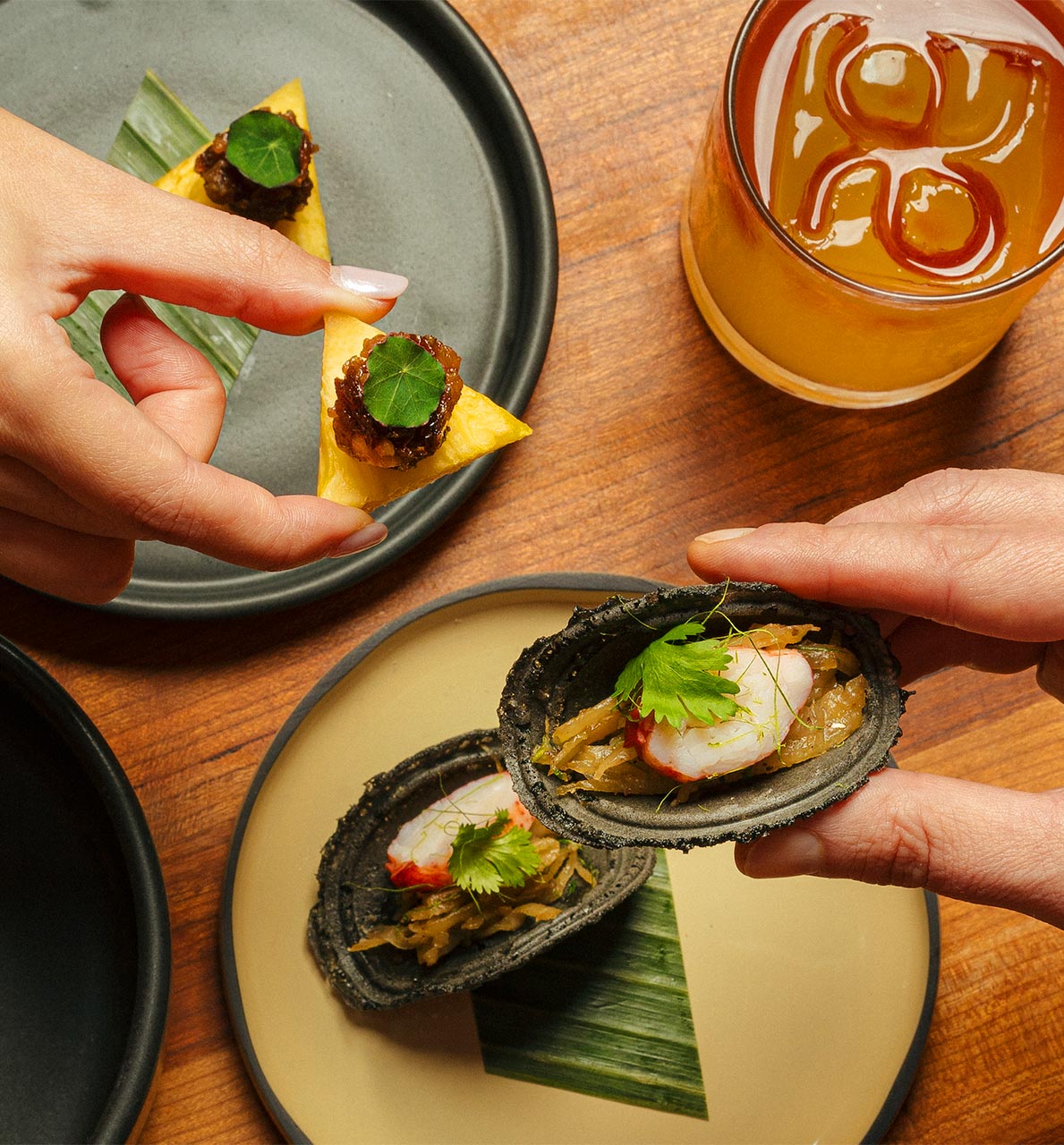ARRIVAL
I begin in the Atago neighbourhood of Tokyo’s Minato Ward. Atago is home to Atago Shrine, famous in the area for its lucky ‘stone steps to success,’ as well as skyscrapers and Tokyo Tower soaring upward just beyond the lush greenery. Taking in the distinctive Tokyo scenery all around me, I arrive at the entrance gate to Seishoji Temple. When I climb the winding stone steps to the side, the sign for Daigo—the One MICHELIN Star shojin ryori I’m here to visit—comes into view,

When first established, this restaurant was located within the grounds of what is now the neighbouring Seishoji Temple, and the head priest named it Daigo. Shojin ryori, a form of vegetarian cuisine, has a long history. It was originally a type of vegetarianism practiced by Buddhists. As part of their Buddhist ascetic training, priests ate only plant-based foods. Today, as many diverse food cultures and customs are recognised and supported, Shojin ryori is now a style of Japanese cuisine attracting worldwide attention. Daigo follows the Buddhist philosophy of the Three Minds and offers a unique take on shojin cuisine. Despite shojin ryori’s focus on vegetarian ingredients, this restaurant uses bonito-flake broth in many dishes, believing that serving delicious food is paramount to hospitality.
・A great mind An unbiased, free-thinking mind
・A joyful mind A mind that embraces joy
・An elder’s mind A kind and considerate mind
With these three minds at its heart, the restaurant displays creativity unrestrained by any fixed ideas so that guests can enjoy the finest hospitality during their visit.

As a kimono-clad waitress guides me into a room, elegant garden scenery comes into view. I’m visiting just before the start of summer, as the plants that have overcome the chill of winter grow beautifully verdant and colourful. The doors near the garden are kept slightly ajar, letting a pleasantly refreshing breeze circulate through the dining space.

First, I observe the room layout, the hanging scrolls, the furnishings, and the sukiya-style architecture reminiscent of a traditional Japanese teahouse. The wrapper around the chopsticks on the table read ‘lightning protection chopsticks.’
The waitress explains that ‘These chopsticks are made from special Japanese yew trees in the Hida region of Gifu Prefecture . These trees are said to be so lucky that they even prevent lightning strikes, and the emperor actually has a sceptre made from this same type of wood. After the meal, guests are encouraged to take these chopsticks home with them as a souvenir.’
PRE-MEAL PRACTICE
The Gokan no Ge, five reflections recited by Zen Buddhists before a meal, are also printed on the chopstick wrappers.1. Reflect on the processes that brought you this food and feel gratitude to all.
2. Reflect on your daily actions and consider if your behaviour is worthy of receiving this meal.
3. Strive to not have a jealous heart and to avoid wrong actions.
4. Recognise that good food is medicine consumed for the purpose of living a healthy life.
5. Accept this food as an offering in order to continue your life and practice.
I am thankful even to the flowers and plants for their offering of life, and I acknowledge this with a sincere heart. I prepare my spirit and pick up my chopsticks.

THE MEAL
Japanese cuisine also shows a respect for luck and incorporates elements of superstition. One example of this is Shikisai Kyuro Yose. This dish associated with the traditional Boy’s Day Festival (today also called Children’s Day) was named after a famed Sengoku military commander Minamoto no Yoshitsune who was also a superb flautist. Yoshitsune was known as ‘Kuro,’ but because this spelling sounds similar to ‘kurou,’ the Japanese word for ‘hardship’ which has negative connotations, the dish name uses ‘kyuro’ instead.
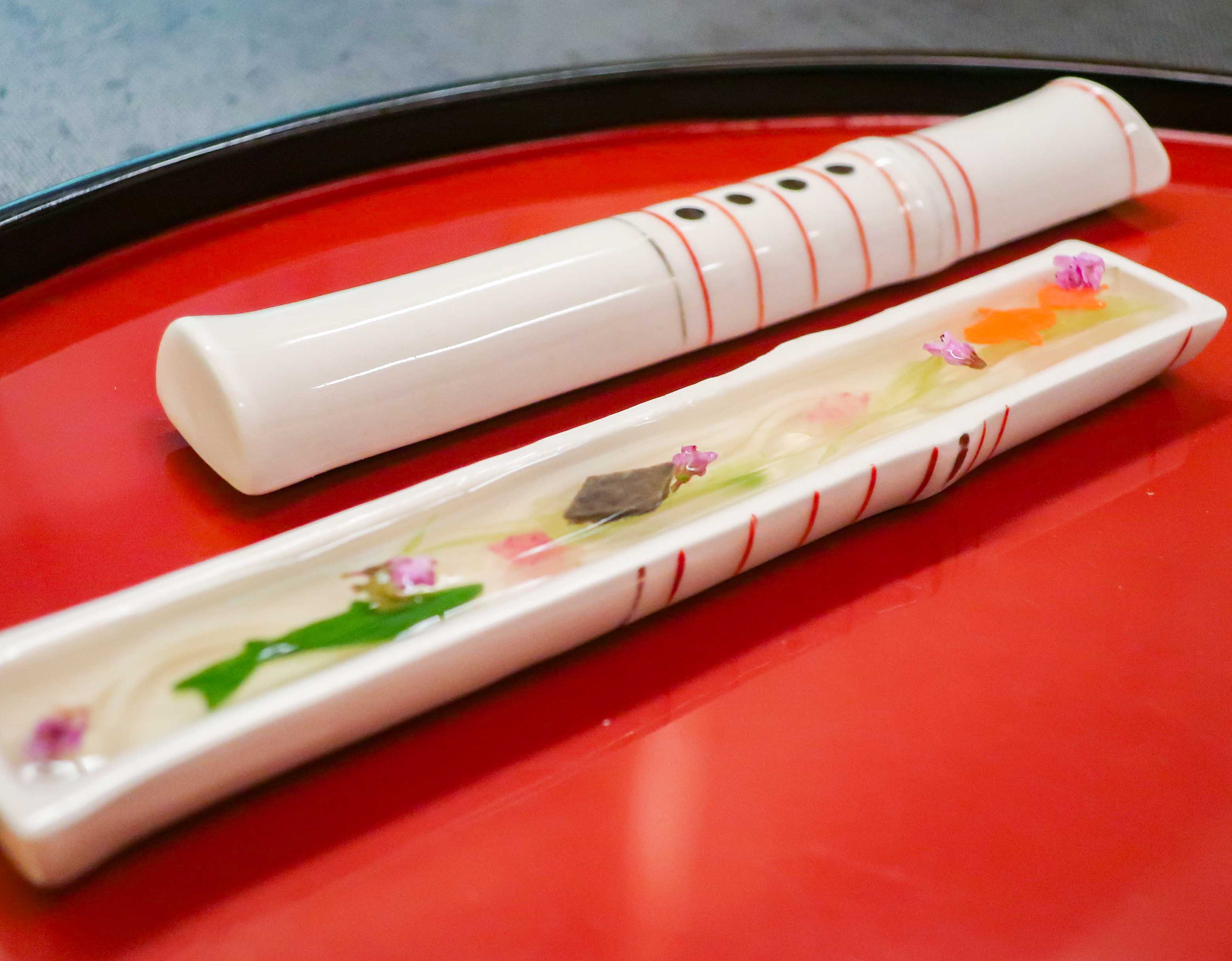
Fava Bean Surinagashi Soup
This soup is served in a bowl with colours which perfectly suit the new greenery of spring. It has contrasting flavours and textures from the sweetness of the taro and the flavourful rice crackers.
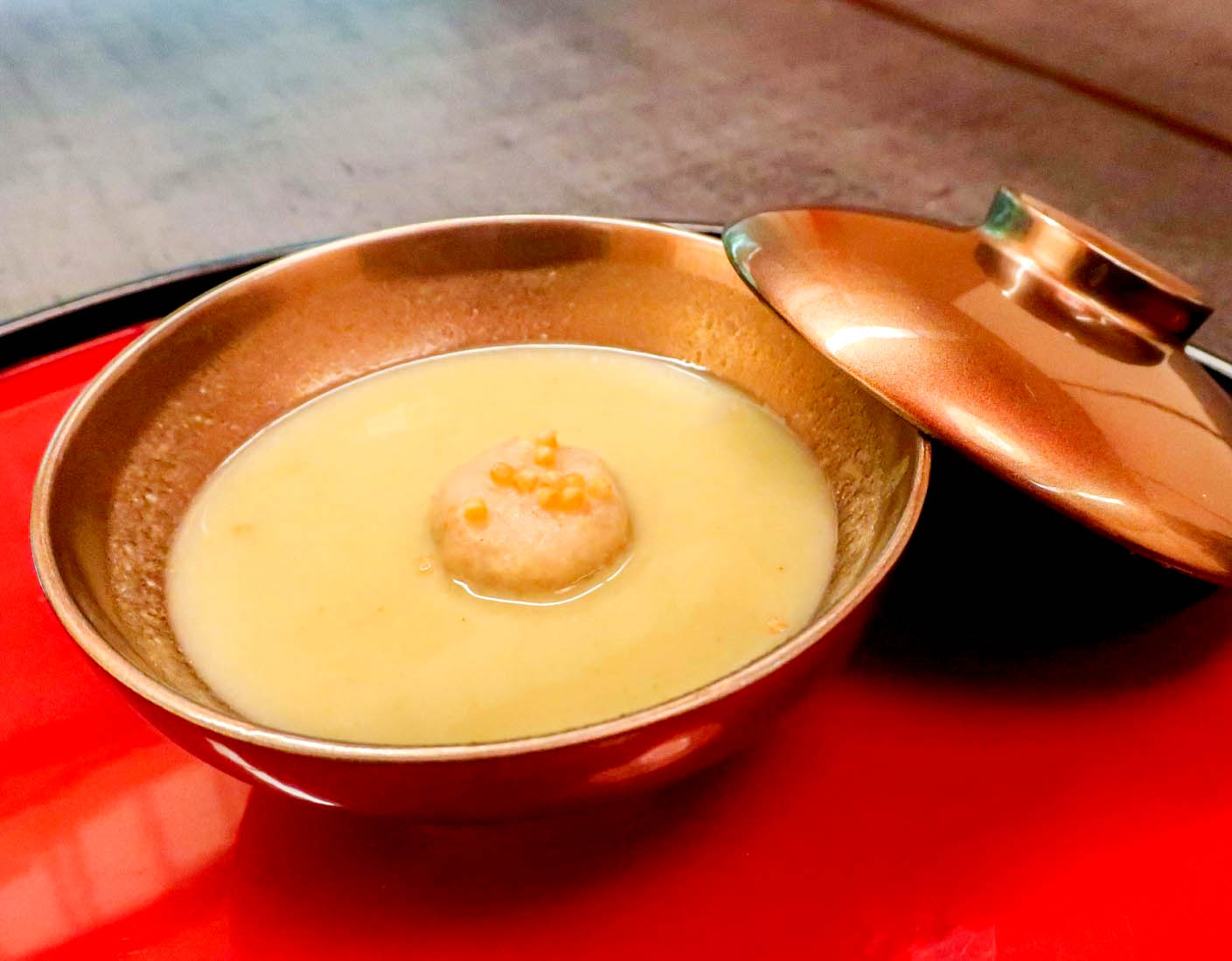
Shojin Soba
This local delicacy featuring soba buckwheat noodles forms a crucial centrepiece for the menu. The waitress removes the lid of the beautifully handmade lacquerware bowl. Mustard, dried seaweed and spring onion are served alongside as condiments for the tororo soba.

Hassun
Reflecting the season of the year or a traditional Japanese occasion, hassun trays are a captivating highlight of Japanese cuisine. One example named for the Boy’s Festival features lotus root formed into a bow and arrow, with Japanese daikon radish as the target. The lotus root is flavoured with sesame sauce, and the daikon radish is wrapped with deep-fried bean curd. The rice dumplings have wheat-gluten inside. Resembling a horse’s bridle, the tezuna handrope sushi is beautifully colourful with carrots, cucumber and shiitake mushrooms. The simmered green soybeans also add colour to the dish.

Toji Yuba-wrapped Koya Tofu
Many types of yuba-based dishes have ‘Toji’ in their name because yuba (tofu skin) used to be produced at Kyoto’s Toji Temple (Kyo-Ogokokuji Temple ). This dish offers the sweetness of soybeans, highly nutritious ingredients, and top-notch quality.

Nameko Mushroom Porridge
This is another famous local delicacy. It uses bonito flake broth. The pickled vegetables shown here are sour Japanese plums and miso-marinated, savoury burdock.

CONCLUSION
During this short time, I appreciated the beauty of Shojin ryori which let me feel drawn closer to Japanese culture again.
Japanese cuisine also reflects the seasons and cultural events of the year. The sukiya architecture of the building, the tatami mats, the hanging scrolls, the furnishing, the garden view, the waitress’s elegant manners and kimono, and the cuisine and dishes were all truly impressive. I also enjoyed being able to experience Japanese art as an integral aspect of everything I felt and did there.
We live in an age where festivals, seasons and customs important to Japanese people are gradually being forgotten with the passage of time. But by spending just a few hours at Daigo, I was able to immerse myself in that beautiful old culture of Japan.
So why not take a moment to put down your smartphone, feel gratitude for the life right in front of you, and take in that culture?

Related articles:
What Does “Good Food” Mean to a MICHELIN Guide Inspector?
An Interview with a MICHELIN Guide Inspector
Top Image: ⒸDaigo







